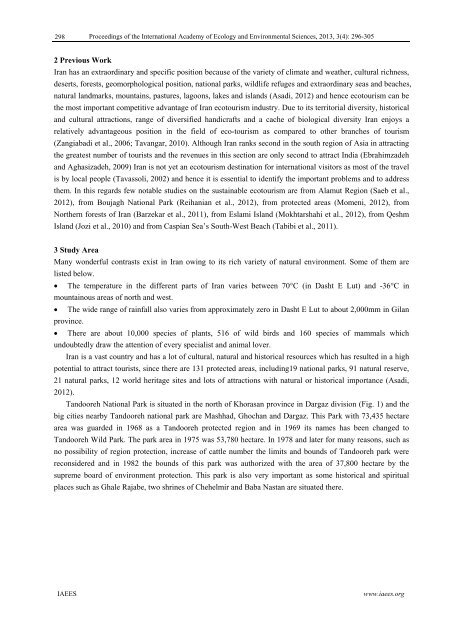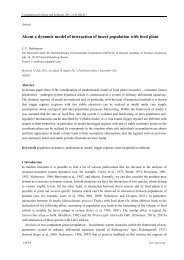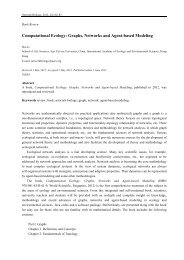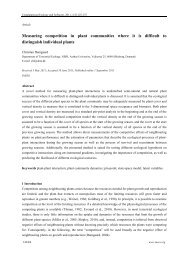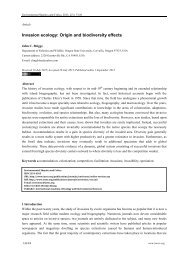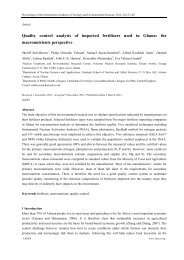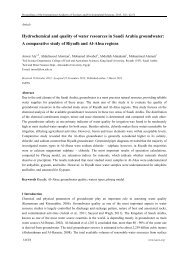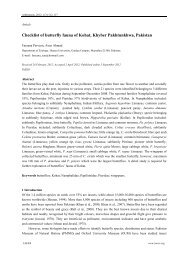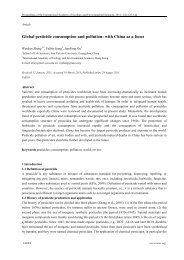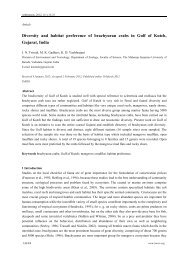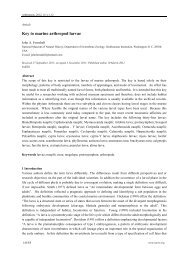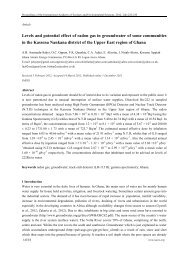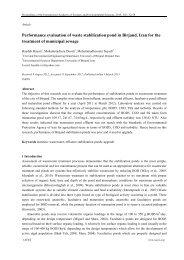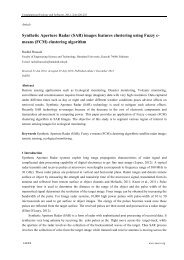SWOT analysis of Tandooreh National Park (NE Iran) for sustainable ...
SWOT analysis of Tandooreh National Park (NE Iran) for sustainable ...
SWOT analysis of Tandooreh National Park (NE Iran) for sustainable ...
You also want an ePaper? Increase the reach of your titles
YUMPU automatically turns print PDFs into web optimized ePapers that Google loves.
298<br />
Proceedings <strong>of</strong> the International Academy <strong>of</strong> Ecology and Environmental Sciences, 2013, 3(4): 296-305<br />
2 Previous Work<br />
<strong>Iran</strong> has an extraordinary and specific position because <strong>of</strong> the variety <strong>of</strong> climate and weather, cultural richness,<br />
deserts, <strong>for</strong>ests, geomorphological position, national parks, wildlife refuges and extraordinary seas and beaches,<br />
natural landmarks, mountains, pastures, lagoons, lakes and islands (Asadi, 2012) and hence ecotourism can be<br />
the most important competitive advantage <strong>of</strong> <strong>Iran</strong> ecotourism industry. Due to its territorial diversity, historical<br />
and cultural attractions, range <strong>of</strong> diversified handicrafts and a cache <strong>of</strong> biological diversity <strong>Iran</strong> enjoys a<br />
relatively advantageous position in the field <strong>of</strong> eco-tourism as compared to other branches <strong>of</strong> tourism<br />
(Zangiabadi et al., 2006; Tavangar, 2010). Although <strong>Iran</strong> ranks second in the south region <strong>of</strong> Asia in attracting<br />
the greatest number <strong>of</strong> tourists and the revenues in this section are only second to attract India (Ebrahimzadeh<br />
and Aghasizadeh, 2009) <strong>Iran</strong> is not yet an ecotourism destination <strong>for</strong> international visitors as most <strong>of</strong> the travel<br />
is by local people (Tavassoli, 2002) and hence it is essential to identify the important problems and to address<br />
them. In this regards few notable studies on the <strong>sustainable</strong> ecotourism are from Alamut Region (Saeb et al.,<br />
2012), from Boujagh <strong>National</strong> <strong>Park</strong> (Reihanian et al., 2012), from protected areas (Momeni, 2012), from<br />
Northern <strong>for</strong>ests <strong>of</strong> <strong>Iran</strong> (Barzekar et al., 2011), from Eslami Island (Mokhtarshahi et al., 2012), from Qeshm<br />
Island (Jozi et al., 2010) and from Caspian Sea’s South-West Beach (Tabibi et al., 2011).<br />
3 Study Area<br />
Many wonderful contrasts exist in <strong>Iran</strong> owing to its rich variety <strong>of</strong> natural environment. Some <strong>of</strong> them are<br />
listed below.<br />
The temperature in the different parts <strong>of</strong> <strong>Iran</strong> varies between 70°C (in Dasht E Lut) and -36°C in<br />
mountainous areas <strong>of</strong> north and west.<br />
The wide range <strong>of</strong> rainfall also varies from approximately zero in Dasht E Lut to about 2,000mm in Gilan<br />
province.<br />
There are about 10,000 species <strong>of</strong> plants, 516 <strong>of</strong> wild birds and 160 species <strong>of</strong> mammals which<br />
undoubtedly draw the attention <strong>of</strong> every specialist and animal lover.<br />
<strong>Iran</strong> is a vast country and has a lot <strong>of</strong> cultural, natural and historical resources which has resulted in a high<br />
potential to attract tourists, since there are 131 protected areas, including19 national parks, 91 natural reserve,<br />
21 natural parks, 12 world heritage sites and lots <strong>of</strong> attractions with natural or historical importance (Asadi,<br />
2012).<br />
<strong>Tandooreh</strong> <strong>National</strong> <strong>Park</strong> is situated in the north <strong>of</strong> Khorasan province in Dargaz division (Fig. 1) and the<br />
big cities nearby <strong>Tandooreh</strong> national park are Mashhad, Ghochan and Dargaz. This <strong>Park</strong> with 73,435 hectare<br />
area was guarded in 1968 as a <strong>Tandooreh</strong> protected region and in 1969 its names has been changed to<br />
<strong>Tandooreh</strong> Wild <strong>Park</strong>. The park area in 1975 was 53,780 hectare. In 1978 and later <strong>for</strong> many reasons, such as<br />
no possibility <strong>of</strong> region protection, increase <strong>of</strong> cattle number the limits and bounds <strong>of</strong> <strong>Tandooreh</strong> park were<br />
reconsidered and in 1982 the bounds <strong>of</strong> this park was authorized with the area <strong>of</strong> 37,800 hectare by the<br />
supreme board <strong>of</strong> environment protection. This park is also very important as some historical and spiritual<br />
places such as Ghale Rajabe, two shrines <strong>of</strong> Chehelmir and Baba Nastan are situated there.<br />
IAEES<br />
www.iaees.org


